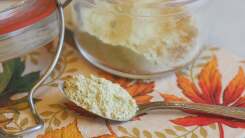Not All Salt Is the Same
If you’ve ever taken a basic chemistry course, you know the substance we casually call “salt” is merely one kind of salt. A salt is simply a chemical compound consisting of a positively charged ion (a cation) and a negatively charged ion (an anion). The salt we typically sprinkle on our food is sodium chloride—NaCl if you’re dweeby—and it makes food taste good.

Pink salt, black salt, red salt and the like all get their color from tiny, pretty much negligible amounts of minerals and other impurities, or at least things that would be considered impurities if you were trying to crystalize pure sodium chloride. Yes, a lot of table salt contains iodine, but only 45 micrograms (0.000045 grams) per gram, which—for our purposes—is not enough to worry about. (Some people who avoid sodium for medical reasons season their food with potassium chloride, but I’ve never tried it.) But even within the realms of colorless sodium chloride, there is one big variation between salts that can affect your food and cooking: Crystal size.
Table salt, for instance, has a compact crystal structure; the grains are tiny, highly ordered cubes. The flakes of something like Maldon, on the other hand, are thin, sprawling pyramids. The former fits into a teaspoon much more easily than the latter, so one-to-one swaps don’t make any sense if you’re measuring by volume. This is why it’s pretty important to pay attention to the type of salt specified in a recipe. If a recipe calls for a tablespoon of Kosher salt, using a tablespoon of a fine sea salt or table salt will result in an over-seasoned dish, as Kosher salt has a much larger crystal structure than either of the other two.

If you don’t have the salt called for in a recipe, or simply want to use a different one, measure instead by mass. You can find the masses of most salts pretty easily online, so just type “how much does a teaspoon of X Brand Kosher salt weigh?” into your browser (different brands can have different masses), note the mass, then weigh out that amount of whatever salt you’re working with. The impurities in pink, red, and black salts might throw your calculations off a bit, but those are better suited for finishing anyway—cooking with them hides their light under a bushel, so to speak.
Updated at 11:40 am PST on 3/24/21 to clarify how to search for salt mass.
RECOMMENDED NEWS

Make Rounder, Prettier Truffles With a Melon Baller
Chocolate truffles are the cheeseball of the dessert world: high-impact, low-effort, and they never ...

The First 15 Things You Should Cook In Your New Air Fryer
This year felt, in many ways, like a repeat of the one that came before it. Covid is still around, o...

There's More Than One Way to Make 'Authentic' Cornbread
Few dishes are as political and polarizing as cornbread. If you think the pineapple on pizza debate ...

The Only Way to Reheat Mashed Potatoes
Unlike soups, stews, braises, and chilis, mashed potatoes do not taste better after an overnight res...

I Could Not Find the Trader Joe's Thanksgiving Seasoning So I Made My Own
As I type these words, I am eating a pile of fries that taste like the last Thursday in November. Th...

Four Ways to Use Your Leftover Amarena Cherry Syrup
Fishing out the last stem from a jar of Amarena cherries is extremely disappointing—even more upsett...
Comments on "Not All Salt Is the Same" :